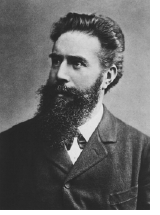Wilhelm Conrad Röntgen
physicist, b. 27 March 1845 (Lennep, Prussia [today's Remscheid, Germany]), d. 10 February 1923 (Munich)
 The only son of a cloth merchant from Lennep in the Lower Rhine province, Wilhelm Röntgen moved with his family to the Netherlands when he was three years old. He went to boarding school and a technical school in Utrecht. In 1865 he joined the University of Utrecht to study physics but learnt that he did not satisfy the entry requirements. The Polytechnic of Zurich in Switzerland accepted students who passed an examination, so Röntgen sat for the examination and enrolled in mechanical engineering. He graduated with a Ph.D. from the University of Zurich in 1869 and was appointed assistant to one of his professors, whom he followed to Würzburg and then to Strasbourg.
The only son of a cloth merchant from Lennep in the Lower Rhine province, Wilhelm Röntgen moved with his family to the Netherlands when he was three years old. He went to boarding school and a technical school in Utrecht. In 1865 he joined the University of Utrecht to study physics but learnt that he did not satisfy the entry requirements. The Polytechnic of Zurich in Switzerland accepted students who passed an examination, so Röntgen sat for the examination and enrolled in mechanical engineering. He graduated with a Ph.D. from the University of Zurich in 1869 and was appointed assistant to one of his professors, whom he followed to Würzburg and then to Strasbourg.
In 1874 Röntgen was appointed lecturer at the University of Strasbourg. He took up a series of positions, among others at the universities of Giessen, Würzburg, Leipzig and finally Munich in 1900, where he stayed for the rest of his life.
Röntgen's first publications, which appeared from 1870 onwards, dealt with the specific heats of gases, the thermal conductivity of crystals, the electrical and other characteristics of quartz, the influence of pressure on the refractive indices of various fluids, the modification of the planes of polarised light by electromagnetic influences, the variations in the functions of the temperature and the compressibility of water and other fluids, the phenomena accompanying the spreading of oil drops on water and other topics.
The work that established Röntgen's fame and in 1901 gave him the first Nobel Prize ever awarded was his investigation of the passage of electric current through highly rarefied gases that led to the discovery of X-rays. Several scientists had already worked with devices known as cathode-ray tubes (glass tubes filled with a gas of extremely low pressure) and shown that the very high tension electricity generated by an induction coil generated a current in the form of rays. Röntgen enclosed the tube in a sealed, thick black carton to exclude all light and found that if he worked in a dark room, a paper plate covered on one side with barium platinocyanide placed in the path of the rays became fluorescent even when it was as far as two metres from the discharge tube.
By placing the hand of his wife in the path of the rays over a photographic plate, Röntgen produced an image of the hand's bones and a ring his wife was wearing, the first "röntgenogram" ever taken. He verified through further experiments that the image was produced by the impact of cathode rays of unknown nature, which he called X-rays. (In Germany they became known as Röntgenstrahlen.)
The practical applications of his discovery were immediately obvious, and Röntgen received numerous prizes and honours but remained the modest and reticent person he had been from the beginning of his career.
Reference
Nobel e-Museum, the Official Web Site of The Nobel Foundation (2004) Wilhelm Conrad Röntgen. http://www.nobel.se/physics/laureates/1901/rontgen-bio.html (accessed 25 July 2004); based on Nobel Lectures. Physics 1901-1921, Elsevier Publishing Company, Amsterdam, 1967.
home
 The only son of a cloth merchant from Lennep in the Lower Rhine province, Wilhelm Röntgen moved with his family to the Netherlands when he was three years old. He went to boarding school and a technical school in Utrecht. In 1865 he joined the University of Utrecht to study physics but learnt that he did not satisfy the entry requirements. The Polytechnic of Zurich in Switzerland accepted students who passed an examination, so Röntgen sat for the examination and enrolled in mechanical engineering. He graduated with a Ph.D. from the University of Zurich in 1869 and was appointed assistant to one of his professors, whom he followed to Würzburg and then to Strasbourg.
The only son of a cloth merchant from Lennep in the Lower Rhine province, Wilhelm Röntgen moved with his family to the Netherlands when he was three years old. He went to boarding school and a technical school in Utrecht. In 1865 he joined the University of Utrecht to study physics but learnt that he did not satisfy the entry requirements. The Polytechnic of Zurich in Switzerland accepted students who passed an examination, so Röntgen sat for the examination and enrolled in mechanical engineering. He graduated with a Ph.D. from the University of Zurich in 1869 and was appointed assistant to one of his professors, whom he followed to Würzburg and then to Strasbourg.